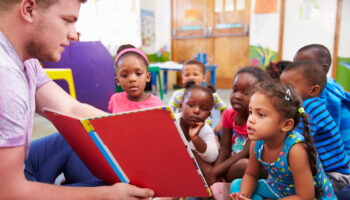By Kelli Harris
A picture walk is previewing the pictures in a book to familiarize a child or group of children with the story prior to introducing the written words to them. Picture walks can pique a child’s interest about a story and help them want to learn more about the story. When you flip through the pictures page by page with the children, you as the teacher, help prepare the child for the story and teach them the importance of visual cues as a reading strategy. Children can begin to “feel” the story. What characters are in the story? Where might the story be taking place? Is it a happy or sad story? Can you predict what might happen? Picture walks also help the children to think chronologically and organize the story into a beginning, middle, and end (first, then, last). Taking a picture walk helps children connect the illustrations in the story to their own personal experiences as well. This can be especially helpful for children who are shy and are having trouble connecting socially with others.
Choose a book with a lot of detailed, colorful illustrations that relate directly to the text. Make sure it is age appropriate and not too long, or children could lose interest. Your school or local librarian can offer great suggestions! Tell the children that before you read the story, you will look at the pictures together to see if you can guess what the story is about. Start by looking at the cover of the book, asking the child(ren) what they see. Ask them what they think the story might be about by using open ended questions about the pictures. Where do you think the dog is going? What is the lady shopping for? How do you think the little girl feels? Why do you think the boy looks so sad? If the children are having difficulty sharing information about the pictures, you can model the strategy by speaking out loud with phrases such as: I am looking at the mother’s face and I think she looks angry. Do you agree with me? Why do you think she is angry? Acknowledge and restate the child(ren)’s answers without giving information about whether the child is correct or not. You think that the elephant will leave the zoo. That’s very possible. I can’t wait to see what happens. You can also chart the children’s responses on chart paper to show how print can be a valuable tool as well.
Then, read the story with the child(ren). Stop to discuss whether the child’s predictions matched what happened in the story or not, when appropriate. Discuss why the prediction matched or didn’t, using information from both the pictures and the text of the story.
Picture walks can be a valuable activity to use in your classroom. By talking to them and allowing the child(ren) to give their responses, this helps to promote children’s language development.
Adapted from “Taking a Picture Walk” by Ellen Milne, Michigan Hands and Voices
 We want to hear from you! Please click the link below to complete a quick survey about your experience reading the “Let’s Talk Quality! PQA in PA” blog. You will be entered to win a prize, that will be awarded at the end of the month. We thank you for your time and welcome your feedback!
We want to hear from you! Please click the link below to complete a quick survey about your experience reading the “Let’s Talk Quality! PQA in PA” blog. You will be entered to win a prize, that will be awarded at the end of the month. We thank you for your time and welcome your feedback!




